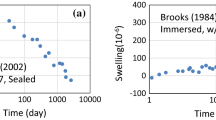Abstract.
Cement paste is formed through a process called hydration by combining water with a cementitious material. Concrete, the worlds most versatile and most widely used material, can then be obtained when aggregates (sand, gravel, crushed stone) are added to the paste. The quality of hardened concrete is greatly influenced by the water confined in the cementitious materials and how it is transmitted through cracks and pores. Here we demonstrate that the water transport in cracks and capillary pores of hardened cement pastes can be approximately modeled by simple equations. Our findings highlight the significance of arresting the development of cracks in cementitious materials used in repository barriers. We also show that neutron scattering is an advantageous technique for understanding how water transmission is effected by gel pore structures. Defining measurable differences in gel pores may hold a key to prediction of the reduction of water transport through cement barriers.
Similar content being viewed by others
References
O. Valenta, Durability of concrete, Proceedings of the 5th International Congress on the Chemistry of Cement, 193-228 (Tokyo, 1968)
A.M. Neville, Properties of Concrete (4th and Final Edition) (John Wiley & Sons, New York, 1996)
H.F.W. Taylor, Cement Chemistry (2nd edition) (Thomas Telford, London, 1997)
T.C. Powers, T.L. Brownyard, J. Amer. Concr. Inst. 18, 2 (1947)
O.M. Jensen, P.F. Hansen, Cem. Concr. Res. 31, 647 (2001)
T.C. Powers, L.E. CopelandH.W. Mann, J. PCA Res. Dev. Lab. 1, 38 (1959)
M.R. Nokken, R.D. Hooton, International Symposium: Advances in Concrete through Science and Engineering (Evanston, IL, 2004)
D. Ludirdja, R.L. BergerJ.F. Young, ACI Mater. J 86, 433 (1989)
The Excel spreadsheet used in this work can be supplied on request to laurie.aldridge@gmail.com
D.P. Bentz, J. Garboczi, Cem. Concr. Res. 21, 324 (1991)
K. Wang, D.C. Jansen, S.P. Shah, A.F. Karr, Cem. Concr. Res. 110, 381 (1997)
R. Temam, Navier-Stokes Equation – Theory and numerical Analysis (North-Holland, 1984)
H. Darcy, Les Fontaines Publiques de la Ville de Dijon (Dalmont, Paris, 1856)
H.N. Bordallo, L.P. Aldridge, A. Desmedt, J. Phys. Chem. B 110, 17966 (2006)
H.N. Bordallo, L.P. Aldridge, P. Fouquet, L.C. Pardo, T. Unruh, J. Wuttke, F. Yokaichiya, ACS Appl. Mater. Interf. 1, 2154 (2009)
H.N. Bordallo, L.P. Aldridge, Z. Physika. Chem. 224, 183 (2010)
H.N. Bordallo, L.P. Aldridge, G.J. Churchman, W.P. Gates, M.T.F. Telling, K. Kiefer, P. Fouquet, T. Seydel, S.A.J. Kimber, J. Phys. Chem. C 112, 19982 (2008)
R. Zorn, NIMA 603, 439 (2010)
C.-M. Aldea, S.P. Shah, A. Karr, Mater. Struct. 32, 370 (1999)
T. Spehr, B. Frick, I. Grillo, B. Stühn, J. Phys.: Condens. Matter 20, 104204 (2008)
K. Morishige, K. Nobuoka, J. Chem. Phys. 107, 6965 (1997)
Y. Zhang, M. Lagi, F. Ridi, E. Fratini, P. Baglioni, E. Mamontov, S. H. Chen, J. Phys.: Condens. Matter 20, 502101 (2008)
F. Ridi, P. Luciani, E. Fratini, P. Baglioni, J. Phys. Chem. B 113, 3080 (2009)
Author information
Authors and Affiliations
Corresponding authors
Rights and permissions
About this article
Cite this article
Bordallo, H., Aldridge, L., Wuttke, J. et al. Cracks and pores – Their roles in the transmission of water confined in cementitious materials. Eur. Phys. J. Spec. Top. 189, 197–203 (2010). https://doi.org/10.1140/epjst/e2010-01323-y
Received:
Revised:
Published:
Issue Date:
DOI: https://doi.org/10.1140/epjst/e2010-01323-y




